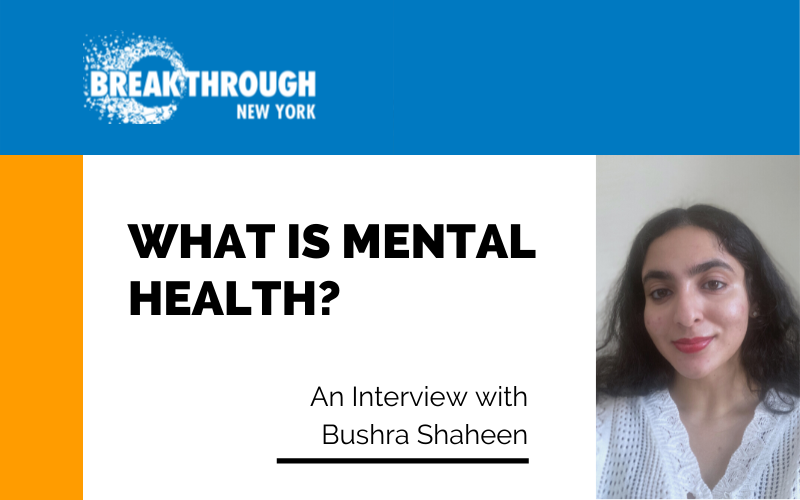May is Mental Health Awareness Month. With schools and businesses focusing more than ever on mental health, we spoke with Bushra Shaheen, Student Support Director at Breakthrough New York, on understanding mental health and how to support those who are struggling.
Tell us about your role with Breakthrough New York.
I am the Student Support Director at Breakthrough New York. Part of my role is providing clinical support to students who may be struggling with mental health. For some students, this is weekly therapy sessions and for others, it’s informal check-ins, case management support, referrals, and sharing resources. I am also responsible for creating the social-emotional learning (SEL) curriculum for our summer programming and providing mental health first aid training to all of our seasonal staff, including mentors and coaches.
What is mental health? Why is it so important for us to take care of?
This is a great question! Mental health refers to our emotional and social well-being and impacts how we think, feel, and behave. When we take care of our mental health, we are able to connect with others, make decisions, handle stress, and manage other aspects of daily life.
May is Mental Health Awareness Month. What do you want more people to understand about mental health?
One really important thing to understand is that mental health differs from mental conditions or mental illnesses, which people might conflate. As I mentioned before, mental health refers to our emotional and social well-being and impacts how we think, feel, and behave. A mental health condition, on the other hand, refers to a wide range of disorders as identified by the DSM-V that affect mood, thinking and behavior.
People might also deal with changes in emotions, thinking, and/or behavior; however, that does not necessarily mean there is anything wrong with them – or with you if you are noticing these changes. We all have difficult moments and a bad mental health day does not necessarily indicate a mental health condition.
In some cultures and communities, there is a stigma around discussing mental health issues. What can we do to reduce this stigma?
Some ways to reduce stigma include having conversations with friends, families, and communities and challenging what you’re hearing. There is a lot of information on social media and it’s important to filter out what is true versus what is perpetuating stigma. Something as simple as asking yourself, “Where did this thought or idea come from? Is it my own, or did someone pass this thought/belief on to me based on their own stigma?” can make a difference.
What can we do to support young people who may be struggling with mental health issues?
It can feel like such a small thing but just listening. And listening specifically to listen, not to respond or to fix. Young people are really the experts in their lives and their own experiences. Approaching conversations with the intent of just providing space for them to share, release emotions, and be heard can be so useful.
Where can we find more resources to learn more?
Take a look at Breakthrough New York’s mental health resource guide, created by our incredible AmeriCorps member, Juliette Geilfuss. The resource guide outlines hotlines and crisis support, mental health centers with referral information, podcasts, support groups, and so much more.
If you are a Breakthrough New York student and are concerned about changes in your emotions, thinking, or behavior, reach out to Bushra at bushra@btny.org for support or more information.


